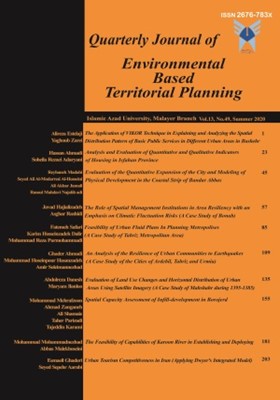The Feasibility of Capabilities of Karoon River in Establishing and Deploying Leisure-Time Places and Water Sports in Ahvaz
Subject Areas :
Mohammad Mohammadnzhad
1
,
Abbas MalekHoseini
2
![]()
1 - Phd candidate of geography & urban planning, geography department, Malayer branch, Islamic Azad University, Malayer, Iran
2 - associate professor at geography & urban planning, geography department, Malayer branch, Islamic Azad University, Malayer, Iran
Keywords: Feasibility Study, Ahvaz, Karoon River, water sports places, water festival,
Abstract :
Some cities have different roles due to their geographical and natural location and trough the formation of rivers. In some cities, such as Ahvaz, since ancient times, with the construction of a dam on the Karun River, the transfer of water for agricultural purposes, drinking, mills and transportation of commercial goods of citizens have been common. The purpose this research is to study the current situation and feasibility study of the potentials and capabilities of spatial, economic, recreational and services appropriate to the population adjacent to Karoon river in Ahvaz. The method of this research is analytical and descriptive and the necessary data were collected through observation, interview, questionnaire and also using documents such as map, statistics, book, article, report. The random sampling method was applied in five municipal districts adjacent to Karoon and two environments, namely, educational and academic ones, were selected to achieve the results of the study. The results of the study showed that in spite of the lack of preparation near Karoon river, the existing potentials and capabilities of the city have not been appropriately tapped.
1- آمار ایران، 1395، نتایج تفصیلی سرشماری عمومی نفوس و مسکن 1395، سازمان برنامه و بودجه کشور مـرکـز آمـار ایـران، صفحه 64.
2- احمدی بابادی،ف،آبان 1391،ساماندهی حاشیه رودخانه کارون،سایت اینترنتی سازه نیوز.
3- بابادی شوراب،ز، 1392،سدهای لاستیکی؛حلقه مفقوده مدیریت آب در خوزستان، سایت اینترنتی شوشان.
4- بحرینی، ح، 1390، تجدد، فرا تجدد و پس از آن در شهرسازی، چاپ چهارم، انتشارات دانشگاه تهران،302.
5- بوستانی، م، دانشپور، ع،کافی، م،1392، اهمیت مطالعهی محیطی منظر رودخانههای درون شهری، مطالعه موردی رودخانه کارون اهواز، کنفرانس بینالمللی عمران، معماری و توسعه پایدار شهری، دانشگاه آزاد اسلامی واحد تبریز.
6- پورمحمدی، م، 1387، برنامهریزی کاربری اراضی شهری، چاپ چهارم، انتشارات سمت.
7- تورکیلدسن، ج، صفانیا، ع، پیرعلی، م، دوستی، م، 1392، مدیریت اوقات فراغت و تفریحات سالم، چاپ اول، نشر بامداد کتاب.
8- دانشمند، ف، نظریان، ا، 1389 تقویت روحیه شهروندی در مدیریت کلانشهرها(مطالعه موردی: شهر همدان) فصلنامه آمایش محیط، 8 (دوره)، 88.
9- رشیدی، مریم،1394، مطالعه تغییرات ژئومورفولوژی بستر رودخانه کارون و علل آن از سال 1334 تا 1391، پژوهشهای ژئومورفولوژی کمی، سال پنجم شماره 1، تابستان 1395.
10- سبحانی، ز، پورمحمدی، م،1390، اوقات فراغت و فضاهای شهری تهران، جغرافیا و برنامه ریزی، بهار1390، شماره 16تا35 .
11- ضیایی، م، 1388 جغرافیای گردشگری، چاپ پنجم، 1392، دانشگاه پیام نور،184.
12- کاظمی، ح، رحمانی، ب، 1399،ارزیابی حکمرانی خوب شهری برای شهرهای ایران (مطالعه موردی: شهر اهواز)، فصلنامه آمایش محیط، 48(دوره13)، 90.
13- محمدپور، س، 1395، تفاوت بین سد، سرریز و آببند، مؤسسه آموزشی و مهندسی 808 آموزشهای تخصصی و عمران و معماری.
14- مرشدی، ج، دیماه 1391، بررسی تغییرات طولی رودخانة کارون با استفاده از روش میانگین جهتدار خطی (منطقة مورد مطالعه: از شوشتر تا اروند)، محیط شناسی، شمارة 4، (دورة 39)، 104-89.
15- مقتدایی، عبدالحسین، 1394، طرحها و پروژههای عمرانی استان خوزستان، اداره کل روابط عمومی و امور بین الملل استانداری خوزستان، 68
16- هاگت، پ، گودرزی نژاد، ش، 1390، جغرافیای ترکیبی نو جلد دوم، چاپ هفتم، انتشارات سمت.
17- هندرسون،ک،پورسلطانی زرندی، ح،1393آفرینش، ا، زرگر، ط، اوقات فراغت، چاپ اول، نشر ورزش.
18- یزدی، ف، نظریان، ا، 1385، کلانشهرها و بررسی تطبیقی روند تحولات آنها(نمونه موردی: کشورهای ایران، ژاپن، استرالیا)، فصلنامه آمایش محیط، 1(دوره)، 4
19- Balchin,paul& Bull Gregory;Urban Economics and public policy; 5th ed., Millan,1995
20- McAuslan, p.(1985):Urban Land and Shelter for the poor: london: international
21- instate for Environment and Development
22- Zukin,s,(1998)'Urban lifestyles:diversity and standardization in spaces of consumption',Urban studies 35/5-6:625-39.
_||_

